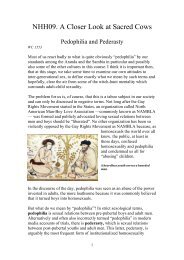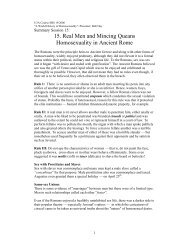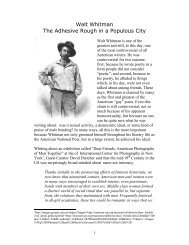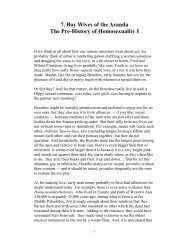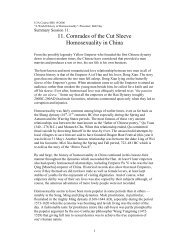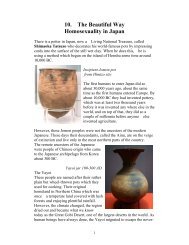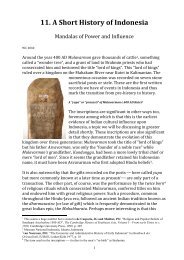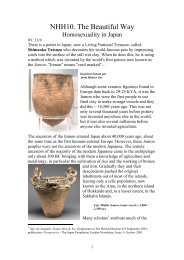15. Real Men and Mincing Queans Homosexuality in Ancient Rome
15. Real Men and Mincing Queans Homosexuality in Ancient Rome
15. Real Men and Mincing Queans Homosexuality in Ancient Rome
Create successful ePaper yourself
Turn your PDF publications into a flip-book with our unique Google optimized e-Paper software.
Later — even until the 5 th Century AD — it was said human <strong>and</strong> animal<br />
sacrifices cont<strong>in</strong>ued to be made to appease the gods <strong>and</strong> ensure the annual<br />
<strong>in</strong>undation on the occasion of the Neilaia, the festival of the Nile, on 22<br />
October each year.<br />
To add <strong>in</strong>sult to <strong>in</strong>jury, the Pharoah Hadrian fully expected his people to<br />
feed him <strong>and</strong> his huge party as they journey up the river. This placed a<br />
terrible burden on the people who had suffered such bad harvests. And, as<br />
far as Ant<strong>in</strong>oüs was concerned, perhaps a further ill-omen was the arrival<br />
to jo<strong>in</strong> the Emperor’s party of Lucius Ceionius Commodus, a h<strong>and</strong>some,<br />
pleasure-lov<strong>in</strong>g aristocrat then aged 29, whom gossip suggested first as a<br />
new lover for Hadrian <strong>and</strong> later, perhaps his potential successor. It is<br />
possible that Ant<strong>in</strong>oüs, now clearly too mature by the rules of pederasty<br />
to cont<strong>in</strong>ue as Hadrian’s eremonos, found Commodius’ presence<br />
disturb<strong>in</strong>g….<br />
The Imperial flotilla made a leisurely progress up the river, past<br />
Heliopolis, stopp<strong>in</strong>g at Memphis to visit the famous sanctuary of the<br />
Aphis bull, then at Hermopolis Magna where Hadrian had discussions<br />
with the priests of Thoth (<strong>in</strong> Greek, Hermes), the god of philosophy,<br />
science <strong>and</strong> the arts. This was also a great centre for the arts as well as the<br />
location of the tomb of Petosiris who, it was claimed, had atta<strong>in</strong>ed<br />
immortality. It was also here that a 15-year-old girl, Isidora, had drowned<br />
<strong>in</strong> the Nile a year or two before the Imperial visit, but who had also<br />
atta<strong>in</strong>ed eternal life because such was the gift of the Nile for those who<br />
perished <strong>in</strong> its waters. Isadora had become assimilated <strong>in</strong>to the worship of<br />
Isis, or among the Greeks, become a water nymph.<br />
A little way downstream on the opposite bank of the Nile was a small<br />
settlement called Hir-wer. Apart from a few mud huts, the only build<strong>in</strong>g<br />
of note was a temple Rameses where several gods, <strong>in</strong>clud<strong>in</strong>g Thoth, Ra,<br />
Hathor, Haracte <strong>and</strong> Bes were all worshipped. It was here, <strong>in</strong> the last<br />
week <strong>in</strong> October 130, that the body of Ant<strong>in</strong>oüs was discovered, drowned<br />
like Isadora <strong>and</strong> the ancient pharoahs, <strong>in</strong> the swirl<strong>in</strong>g waters of the Nile.<br />
The mystery <strong>and</strong> deification of Ant<strong>in</strong>oüs<br />
All we know about how <strong>and</strong> why this, perhaps the most famous young<br />
man <strong>in</strong> late Antiquity, came to drown is summed up <strong>in</strong> Hadrian’s own<br />
few words: “He fell <strong>in</strong>to the Nile”. Unfortunately for history, Hadrian<br />
used a verb which could imply either by accident or by <strong>in</strong>tent. The<br />
16



